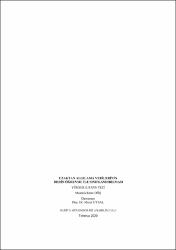Uzaktan algılama verilerinin derin öğrenme ile sınıflandırılması
Özet
Bu araştırmada, uzaktan algılama platformları vasıtasıyla elde edilen görüntülerden kentsel nesnelerin otomatik olarak sınıflandırılması sorunu için Derin Öğrenme ağları önerilmiş ve önerilen ağlar kendi aralarında doğruluk, zaman kullanımı ve ağ karmaşıklığı gibi konularda karşılaştırılmışlardır. Günümüzde anlamsal bölütleme için geliştirilmiş Derin Öğrenme mimarilerinin, uzaktan algılanmış görüntülerde kentsel nesnelerin otomatik sınıflandırılmasında etkili olacağı düşüncesi ile UNet, SegNet ve PSPNet gibi anlamsal bölütlemede kendini kanıtlamış mimariler kullanılmıştır. Sınıflandırma için kullanılan görüntüler Uluslararası Fotogrametri ve Uzaktan Algılama Birliği (UFUAB) kullanıma sunduğu Vaihingen ve Potsdam verileridir. Vaihingen veri setinin eğitim ve test kısmında ücretsiz bulut sistemi olan Google Colab kullanılmış ve bu tür ağların eğitiminde maliyetin düşürülmesi için büyük bir alternatif sunulmuştur. Potsdam veri setinin eğitim ve test aşamasındaysa bir iş istasyonu kullanılmıştır. Yapılan çalışmadaki tüm kodlar Python yazılım dili kullanılarak yazılmıştır. Çalışmadan elde edilen sonuçlara bakıldığı zaman; her iki veri seti içinde genel olarak SegNet daha başarılı performans göstermiştir. UNet’ tende SegNet’ e yakın sonuçlar elde edilmiştir. Ancak PSPNet diğer iki mimariye göre daha kaba görünmektedir. In this research, Deep Learning networks were proposed for the problem of automatic classification of urban objects from images obtained through remote sensing platforms, and the proposed networks were compared among themselves on issues such as accuracy, time use and network complexity. Today, proven architectures have been used in semantic segmentation such as UNet, SegNet and PSPNet with the thought that Deep Learning architectures developed for semantic segmentation will be effective in automatic classification of urban objects in remote sensed images. The images used for classification are Vaihingen and Potsdam data made available by the International Society for Photogrammetry and Remote Sensing (ISPRS). The free cloud system, Google Colab, has been used in the training and testing part of the Vaihingen dataset, and a great alternative has been offered to reduce costs in the training of such networks. A workstation was used during the training and testing phase of the Potsdam dataset. All the codes in the study were written using the Python software language. When the results obtained from the study are examined; SegNet performed more successfully in both data sets. Results similar to SegNet were obtained from UNet. However, PSPNet appears to be more rude than the other two architectures.
Bağlantı
https://hdl.handle.net/11630/8485Koleksiyonlar
- Yüksek Lisans Tezleri [879]



















